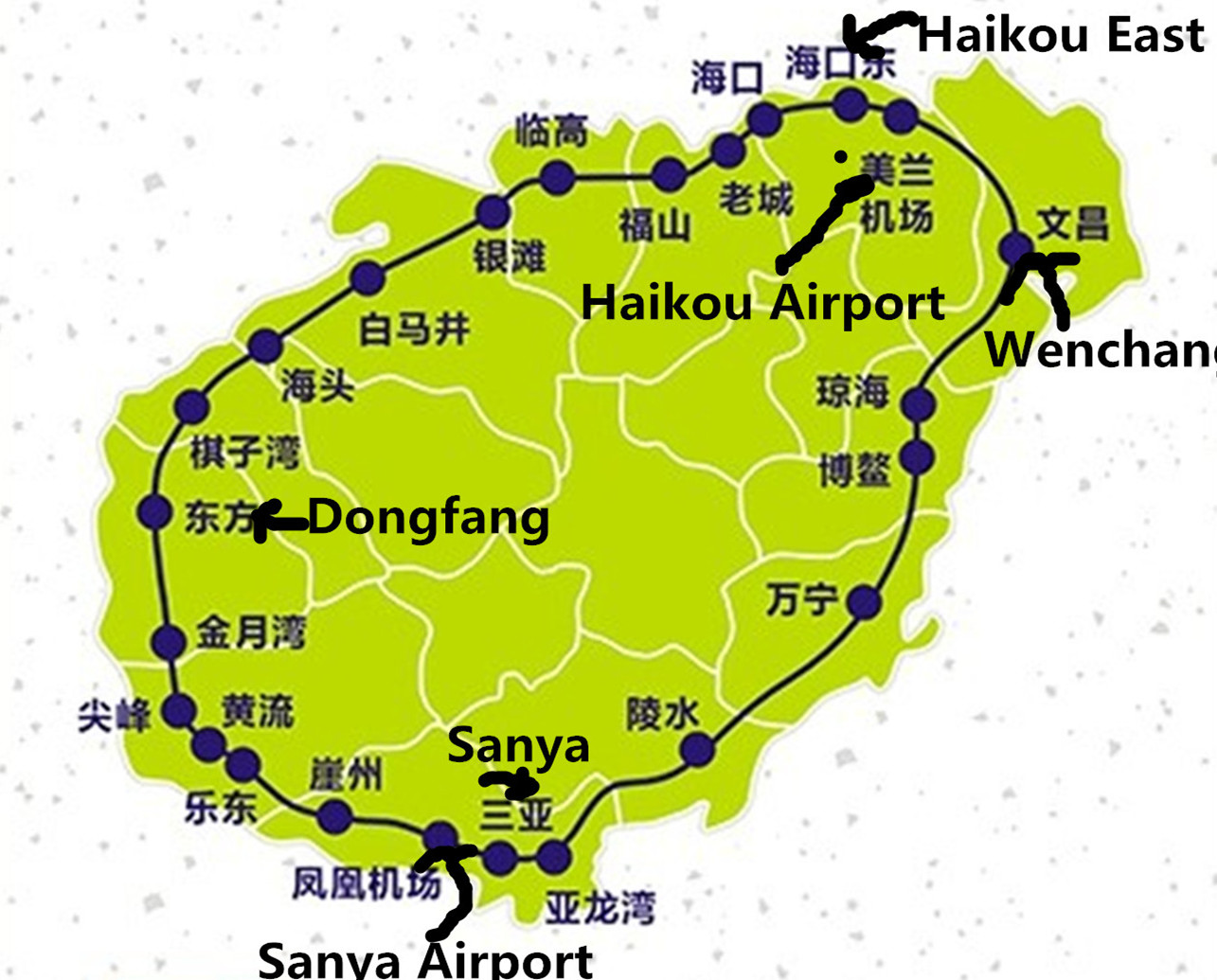
In December 2015, the West Line of Hainan’s much-publicised high-speed railway looped with the East Line in Haikou, creating the world’s first round-island high-speed railway. Departing from Haikou station, we pick a few intriguing spots that prove Hainan is so much more than beaches and pool bars.


Wenchang Station/ Eastern Ring
With half of the island’s coconut plantations flourishing here, Wenchang is a chance to experience the slower-paced tropical life of Hainan. However, with a growing overseas Chinese population, that may well change so it is best to visit sooner rather than later. You will see few tourists on the beaches, meaning you will have most of the whooping 207km of coastline to yourself.

The mangrove forests and coconut groves make for incredible photo ops, and the quiet, sleepy villages are full of cheap and cheerful cafes and bars. Highly recommended are the ‘wild-caught’ lobsters which are often considered the world’s best. For a truly off-the-grid journey, visit Hainan’s mysterious island chain – the Qizhou archipelago. Rather remote, its steep cliffs and foggy peaks were hidden from explorers for hundreds of years. Today, Qizhou represents an ancient world that has seemingly been bypassed by modernity. Most of these islands have tremendous cave systems. On the islands of Shuangfan and Dengzhi, deep caves create natural sea tunnels for small boats to pass through. It is also a paradise for many seabirds, especially nesting terns. For bird lovers, camping is permitted, but it is worth checking the weather reports before your journey.

Qionghai Station/ Eastern Ring
The best thing about Qionghai is that few tourists know of its existence. We visited Jiaji Town, which is steeped in the region’s 2000 year old history, to meet friendly locals and try the tasty cuisine (meandering pathways will lead you towards the old town). The more adventurous can go whitewater rafting upstream of the island’s third largest river, Wanquan River. Known as ‘China’s Amazon’, the lush tropical rainforest that borders this 162-km long river is also a designated conservation zone. The calmer and wider downstream offers the chance to enjoy a relaxing view of the myriad banana plantations from the safe confines of a bamboo raft tour. Along the foot slopes of Baishiling Mountain, Guantang produces natural hot springs over 20 sq km tapped by four resorts. It has a long history among locals, who swear by its health properties.


Lingshui Station/ Eastern Ring

Visiting Lingshui is like a walk back in time. Apart from the gorgeous waterways and sleepy fishing ports, the country is blessed with extraordinary natural beauty. Perhaps most famous of all is Nanwan Monkey Island, a nature reserve for some 1500 macaques on the Nanwan peninsula. Some of these macaques are now semi-tame and can be very curious around visitors as we found out to our detriment – hide your lunch! While on the peninsula, take the cross-sea cable car to view the rainforest from the air. You will also see hundreds of floating houses lined up cheek by jowl along the seashore. These belong to the unique Dan group – sea gypsies living the life aquatic on the South China Sea. Later, spend a day or two on Fenjiezhou Island. This newly developed tourism spot has soft white sandy beaches and a tranquil blue lagoon. If you’re not a PADI-certified diver, there is a sightseeing submarine with a glass bottom that will show you the wonderful marine life around the island’s coral reefs.

Huangliu Station/ Western Ring
Since the 1990s, Huangliu laoya (literally old duck, aged one year) has been a popular dish on Hainan hotel menus. Huangliu laoya is usually poached or stir-fried, served with spicy dipping sauces. Such is the dish’s popularity that it can be found at any street side eatery.

Besides the famed duck, Huangliu also produces most of the salt on the island. The Yinggehai Salt Field has apparently been making salt since the Tang Dynasty. More than 1,000 rocks have been cut flat on the top, leaving a rim around the edge to hold seawater, which covers the rocks in high tide, or is painstakingly carried by villagers in buckets from the sea. Slowly, the sun evaporates the water, leaving pure sea salt on the rocks, which is then put into baskets, and later can be sold. We head to nearby Jinjiling Ridge for a panoramic view of this enormous silver-tinged field.

Dongfang Station/ Western Ring
At the southwestern point of Hainan lies the historical seaport of Dongfang. The ancient village of Baicha, where the Li ethnic group has been living for generations, is probably the last place in China to view traditional Li culture. More than 80 unique dwellings are here, built from straw and mud, giving the appearance of inverted boat hulls crammed together. You can buy their rattan goods and try the famed Dongfang lamb. Visit the tree-lined Macaque Cave on the outskirts of Dongfang City, it is 100 feet deep and there are incredible stalagmites just past the cave’s entrance.

Fun facts
-The train can travel up to speeds of 250km/h.
-The train takes 90 minutes from Haikou to Sanya on the Eastern Ring.
-The earliest train departs from Haikou at 7am, the last train departs from Haikou at 10.30pm.
-There are usually two to three trains operating every hour.
-You will need your passport yo purchase a ticket at the counter.
How to get there?

Scoot and Jetstar flies from Singapore to Haikou five times weekly.
Scoot flies everyday except Wednesdays and Fridays. TR118 7.15am – 10.45am
Jetstar flies everyday except Tuesdays and Thursdays. 3K817 7.35am – 11.05am


